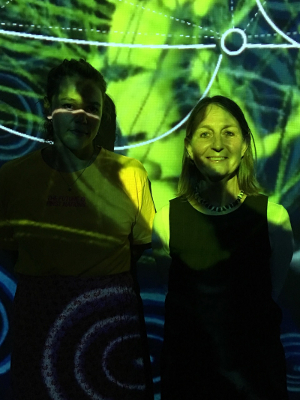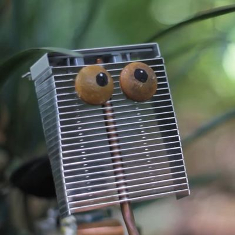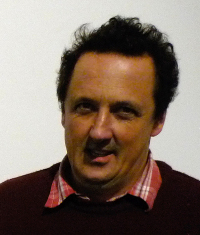Living Data
2019 Impacts:
Seeding Treaty
Introduction/ Archives 2012 2013 2014 2015 2016 2017 2018 2019
Impacts/ Index
Seeding Treaty:Inclusion and Cooperation

Still from Barkindji Story by Maddison Gibbs
in Seeding Treaty
On May 28th I put out this message by Email and on Facebook:
I seek evidence of benefit in the animation "Seeding Treaty", including what we learn from our mistakes. Please watch and Comment, Email or Message a few words about what you take away from that experience.
Directors of the Woodford Festival 'Talks and Ideas' program (in December) ask presenters to write their own program notes and I want to do this in a way that's not the usual self-promoting tick-box exercise.
My purpose in compiling 'Seeding Treaty' was to bring together Indigenous and Western knowledges of our changing lands and waterways. But is this how other people will read our work?
I want to include in my notes for the Woodford Festival program some quotes from people with different life experience and training. I'm asking you because I trust that you will read the work from your own perspective and that your response will be authentic and not mere flattery, or 'Like'.
Please let me know ASAP if you can do this, and if you're happy to be identified in the more extended documentation of 'Seeding Treaty' on the Living Data website. I need something from you by Friday this week.
Thanks, in anticipation, for this new opportunity to learn from you!
Best wishes,
Lisa
RESPONSES to Seeding Treaty:
Our land itself contains the power to seed and grow Treaty - all we have to do is grasp and wield this powerful force, visually, scientifically, and musically. This display of the intricate, multilayered web of life and culture that sustains us all, grasps this power and charges its viewers with a communal responsibility to protect and care for country.
Elizabeth Shepherd,
Indigenous Australian musician and composer, writer and artist
May 28, 2019
I think animated stories are a great way to communicate in an engaging way. Recognising the wealth of Indigenous Knowledge about our world and incorporating these stories gives weight to the seriousness of the topic and just how little we know about how river systems and other life are related. Western science still has a long way to go... This reminds me of the story of how Port Philip came to be flooded - the people were too caught up in their material world and bickering with each other about who had what to be able to look after their environment. As a result, many people died and prime yam growing fields and Kangaroo 'paddocks' were inundated. People who had not drowned now faced starvation. Only through peace and cooperation could people again prosper, however, the rich food growing territory of Port Philip was submerged forever. It seems we live in an age where very few people are interested in such cautionary tales - to our peril.
Nicky Padden,
Indigenous Australian Educator/Scholar
May 28, 2019
Beautiful work sister Lisa 100% with you on the subject of seeding our treaty U believe in making better Relationship with our Prime minister and government officials stay blessed
Catherine Maria Jackson,
Indigenous Australian Artist/Educator
May 28, 2019
The animation of data takes the viewer way beyond the classical approach to trying to understand the world around us. We feel the data in a new way, and experience the connectedness of everything in new light. Time frames and spatial scales are blended and metamorphosed in ways not possible with the more static approaches of science. Much to learn by observing data through other practitioners eyes and experiences.
Ruth Eriksen,
Scientist
May 28, 2019
An apt and timely reminder, when the Prime Minister Of Australia is spending 50 million dollars of tax payers money, to build yet another monument to Captain Cook. This introduction and series of films are an important reminder that real art is not corporate... That people have the power to share their experience, turning it into an art form ...That, while not appearing to be overtly political, subversively IS. The world is ours really, large corporations and non progressive governments are dinosaurs, they just don't know it yet. Reality television is not reality ... This poetic gathering of images IS.
Ian Hartley,
Artist
May 29, 2019
I love it and so impressed with your quick response to put what we heard in the talk [by ...] into action, Wow good on you! The creativity and variety of graphics, images used are outstanding!
My suggestions:- 1. I think that you could include your purpose just as you have explained it below in your email to me, in plain English for westerners: It's simple and succinct. using the purpose, and what seeding treaty "is", in the beginning sets it up and informs the viewer; I love the animated dots that create movement so recognisable from Aboriginal paintings! Awesome!
2. I was thinking about language, could the language used be written both for western audience and aboriginal understanding bringing the two together. I don't know if there is such a thing, I am now realising that they have many different variations in languages. Main idea here is language ->audience Identify the audience. This method is used for teaching, but as an artist, you might want to create a more poetic piece of art. It depends on the objective of your piece. If it is to communicate then -> Can any lay person understand it? A child, a less educated person. Simplicity in language offers better understanding of message.
3. Also, Our brains can only take in 1 main idea per slide (in presentations)and 3 overall ideas per module that we will remember. However, we are talking about Aboriginal stories here, so the script would be more identifiable if it was in a story format. Using your material, I have given an introduction example below in a format that flows addressing Purpose, meaning of terminology used, What this is/The How, the problem, the situation, the solution, call to action. I would overall minimise the number of words, and adjust the flow so people can take in each point with a pause and see the beautiful graphics that connect and accompany it. Our brains get distracted easily, identify focus of each idea. Also reduced text for accessibility/ for the hearing impaired, that have to read the closed captions.
4. Finally, moving the call-to-action to the end of the video "time to speak out". As a viewer, How do we do that? Can it be represented graphically? a suggestion in the narrative, or a link to suggestions. Would you like to continue the use of the Seeding analogy? I really love it! eg Nature will always find a way..
.Suggested reduced wording for script:
Intro
My purpose of 'Seeding Treaty' is to bring together indigenous and Western knowledge of our changing lands and waterways. Seeding Treaty is a suite of animations presented as Living Data. Living Data is a collaborative response to our changing environment, documented on LivingData.net.au. Thanks to digital communication technology, stories can now seed treaties - develop agreements - within ourselves, between ourselves, to care for the our shared natural world that sustains us. Animations have been made in the spirit of inclusion and cooperation, with everyone involved creating part of an evolving bigger story about our relationship with nature.
This spirit is being undermined by personal greed and institutionalised commercial seductions. These work against, not with, the laws of nature. For tens of thousands of years, Aboriginal Australia was sustained by the spirit of inclusion and cooperation with agreements reinforced between its peoples through songlines told in ceremonies. This same spirit of inclusion and cooperation is what drove the Antarctic Treaty. Treaties are agreements for growing and sharing knowledge for the common good.
Nature, Humanity, Truth, the voices of the young
The world is listening!
Your stories won't be muzzled here, in this space.
Scientists, Artists, Indigenous knowledge holders, be called or driven to learn and tell stories for sustaining humanity - physically, biologically, spiritually.
The time has come to speak out and plant our seeds.
Our stories are now being told through inclusion, cooperation across generations, cultures, disciplines...and mediums. nature will always find a way...
I hope this offers a few different ideas, perspectives, things to think about. Thanks for the opportunity to offer my perspectives.
Isabel Cortez,
Academic
May 29, 2019
I love the combination of art, science and Indigenous culture! We often look at things only from our very personal point of view but it's so important to describe and understand things from different perspectives! As a scientist I'm used to describe nature in a pretty objective way but I find it interesting and important to see nature expressed in a different way, from an artist's and indigenous point of view! To me this holistic approach offers a deeper understanding of nature.
Ingo Berghardt,
Scientist
May 31, 2019
In this time of extreme hardship for the planet it is crucial that the word is spread to as many of us as possible that now is our time, the people's time more than ever before. Our understanding, sensitivities and action now might, just might be able to make positive change to our environment and lives for the better. To maximise the message we must use many different inputs. "Seeding treaty" is a wonderful example of this in its use of animation, music, Indigenous story telling and science.
Lynden Nicholls,
Artist/Educator
May 31, 2019
Lisa, after watching the animations, the thing that struck me most clearly was the holistic approach you take to the work you're involved in. Each group (scientists, artists, those who hold Indigenous knowledge) will look at the world in slightly different ways, and the power of your work is the way it provides a space for integration; for not presenting three different perspectives (or multiple perspectives) separately, one at a time (we could look it through this lens ... or this lens ... or this lens ...), but rather for integrating the perspectives, for bringing them together in ways that add power and resonance to our understanding. There is also a subltlety to your work - with symbols used to express particular messages and meanings introduced in ways that are delicate rather than didactic.
Sharon Pittaway,
Writer/Educator
May 31, 2019
One thing - I find the roll of credits during your heart felt & key narrative (beginning 2:04, to 2:32) distracts from your words, & isn't necessary at that point. Rather, I'd stick to the convention & have it at the end. So I suggest:
Give the first animation's title, Seeding Treaty, floating over the trees, a more assertive font (red, splice the credits text out of its current location, have a interlude of image & sound then transition into the next animation, Barkindji Story, which illustrates your dialogue. Conclude with Rivers of Oz
Put the credits for Seeding Treaty, Barkindji Story, & Rivers of Oz, clearly labelled as such, at the end of the 3 animations so the text doesn't interrupt, distract, from the flow of visuals/dialogues.
Then follow with the VCA animations.
Otherwise - perfect
I think Mlissa's & my Mendinee Fish Kill 2019 photo, animated, is very powerful in there. Approved :D
The animations are a matrix of Indigenous knowledge correlating with science (& art), demonstrating of how our multiple voices enhance understanding, empathy and knowledge - well done Lisa!!!
See attached some fonts re/ the Seeding Treaty title - maybe undulating across in front of the trees?
Bonita Ely,
Artist/Educator
May 31, 2019
These are divergent approaches, joining in a single medium: animation. It gives an enormous amount of freedom to the viewer to be inspired and informed.
Eveline Kolijn,
Artist/Educator
May 31, 2019
An interesting and engaging use of images and technology to tell older stories and now issues! We need to have our visual and emotional links stirred to make us think and believe!! (Use if useful, xx
Eva Cox,
Writer/Educator
May 31, 2019
Seeding Treatyis a trio of animations compiled by Maddison Gibbs, Paul Fletcher and Lisa Roberts, to reflect the spirit of inclusion and cooperation that's sustained Aboriginal Australia for tens of thousands of years, and that's at the heart of the Antarctic Treaty System. The work evolved from listening to stories told by scientists and Indigenous knowledge holders. It expands on the basic premise of the Lens on Healthproject, "...that humans and environments are interconnected, and that because world views reflect diverse experiences and beliefs, we must integrate (not separate) our ways of knowing, being and doing, to ensure the diversity in communities and environments that is necessary for sustaining life - physical, biological, emotional".
Seeding Treaty is an ongoing project.

L-R: Maddison Gibbs & Lisa Roberts
Photo: Sandy Edwards


Paul Fletcher and one of his Hidden Creatures
Photos: Supplied by Paul Fletcher











